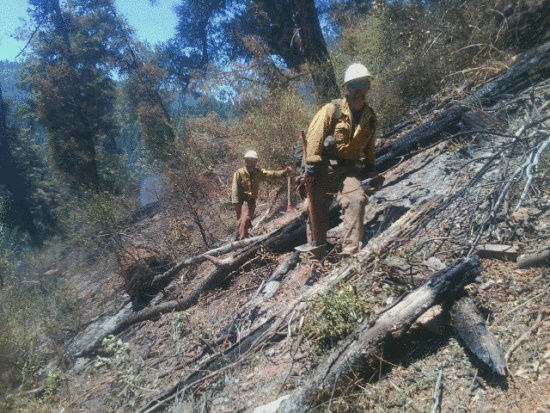Klamath National Forest Hotshots pause while working on the Sugarbowl Fire. [Photo provided by Six Rivers National Forest.]
Six Rivers National Forest press release:
Although drought conditions contributed to an earlier than normal start to the fire season, the interagency fire management staff of the Six Rivers National Forest and Redwood National Park kept the acres burned to less than 1,200 acres on 52 wildfires. The interagency organization, initiated through a “Service First” agreement in early 2014, provides wildland fire protection to more than 1.3 million acres of public and private lands in Del Norte, Humboldt, Siskiyou and Trinity counties.
Seven of the protection area’s 52 fires were lightning-caused and 45 were human-caused. Of the 1,200 acres burned, 25 acres were a result of human-caused fires, while over 1,100 acres were associated with the Happy Camp Complex fire that moved into the protection area late in the season. The remaining acres were associated with six smaller lightning fires.
Considering that much of the summer was spent under very high fire-danger conditions, the outcome could have been very different. “Our areas of emphasis going into this year were fire prevention and response effectiveness,” said Interagency Fire Chief Mike Minton. “Having access to specialized assets like helicopters, hotshot crews and smokejumpers really made a difference when we were working lightning-caused fires in steep and remote areas.” With a ten-year average of 22 lightning-caused fires per year, this year’s 7 lightning-caused fires for the protection area was well below average.
One particularly difficult lightning-caused fire was the Boise incident, located in the upper third of Boise Creek above the community of Orleans. Located a mile from the nearest road, the fire was in extremely steep, heavily timbered terrain. Within a few days, hotshot crews and helicopters assigned to the fire were able to contain it to less than 12 acres. If control had not been achieved in those first days, the fire had the potential to grow to several thousand acres and threaten homes in the area.
Forest Supervisor Merv George contributes the success to the relationships that are formed by working hand-in-hand with partners. “The ability to work effectively with our cooperative partners like CAL FIRE, the Karuk, Hoopa and Yurok tribes, as well as the many local volunteer fire departments and local contractors in these counties, is vital to our mission,” said George.
Interagency fire management staff would like to remind everyone that human-caused wildfires are often preventable; and, although wildfire danger subsides during the wet season, it is still good practice to exercise caution with fire in our communities.

CLICK TO MANAGE